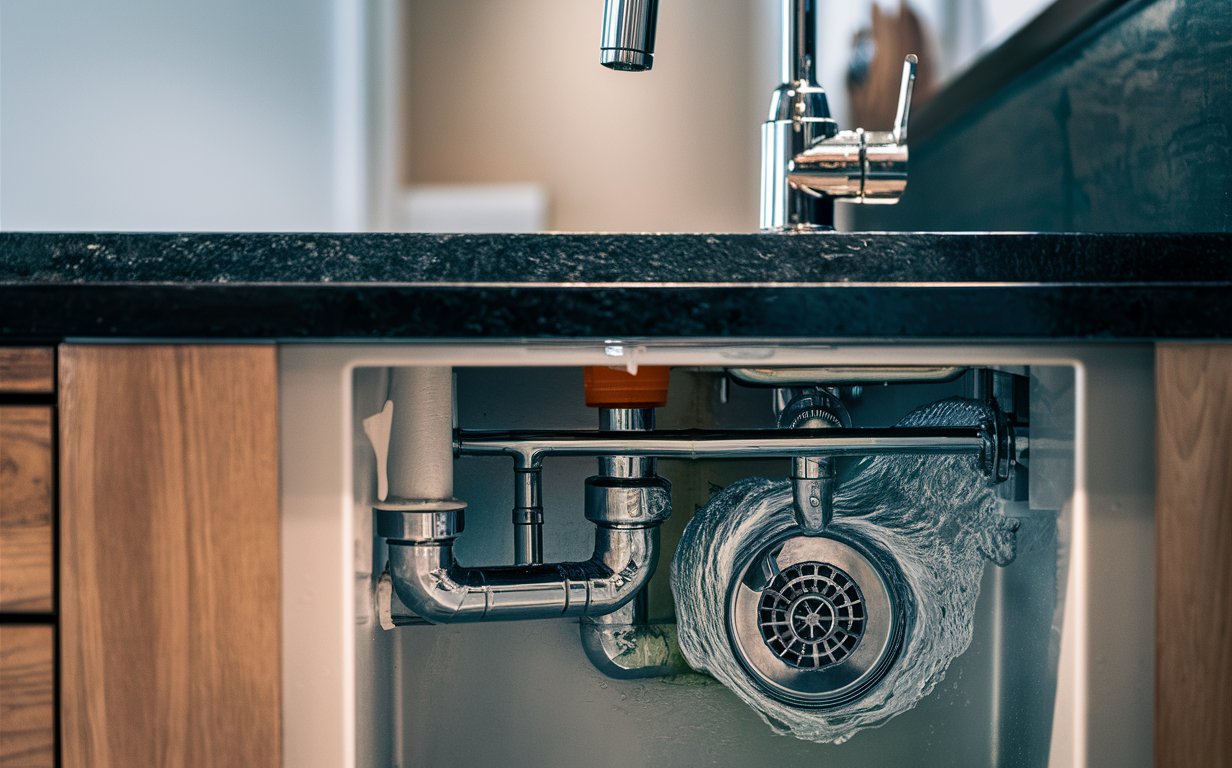Your kitchen sink drain is one of the most used parts of your home—and also one of the most neglected. Every day, it swallows up food particles, grease, soap residue, and other waste. Over time, this can cause a slow drain, bad odors, or full-on blockages that can disrupt your kitchen routine. The good news? You don’t need to rely on harsh chemicals or costly professional services to maintain a clean, fresh-smelling, and free-flowing drain.
In this comprehensive guide, we’ll show you five unique, effective, and natural ways to clean your kitchen sink drain and prevent clogs. Plus, you’ll learn the key signs of a clogged drain, the most common causes, preventive measures, and when it’s time to call in a professional.
📚 Table of Contents
- Why Cleaning Your Kitchen Sink Drain is Essential
- 4 Signs That Your Kitchen Sink Drain Needs Cleaning
- Top Causes of Kitchen Drain Clogs
- Section 1: 5 Unique Ways to Clean Your Sink Drain Naturally
- Boiling Water Technique
- Baking Soda & Vinegar Fizz Method
- Salt & Lemon Scrub
- Enzyme Cleaner Treatment
- The Reliable Drain Snake
- Section 2: Daily and Weekly Maintenance for Long-Term Results
- Section 3: What Not to Put Down the Drain
- Section 4: When and Why to Call a Plumbing Professional
- Q&A: Common Kitchen Sink Drain Cleaning Questions
- Conclusion: Your Path to a Healthy, Clog-Free Kitchen
<a name=”1″></a>
🔍 Why Cleaning Your Kitchen Sink Drain is Essential
It’s easy to forget about your kitchen sink drain—until it starts smelling bad or draining slowly. But regular cleaning isn’t just about avoiding unpleasant odors; it’s about protecting your home’s hygiene and your plumbing system’s long-term health.
💡 Benefits of a Clean Kitchen Sink Drain:
- ✅ Prevents blockages and slow drainage.
- ✅ Eliminates bad odors caused by food decay and bacteria.
- ✅ Reduces the risk of pipe damage from buildup or corrosion.
- ✅ Saves money on plumbing repairs.
- ✅ Maintains a sanitary, pest-free environment.
<a name=”2″></a>
🚨 4 Signs That Your Kitchen Sink Drain Needs Cleaning
Your drain might not be shouting for help, but it does drop some obvious hints. Here are the top warning signs that your drain needs a good clean:
1. Slow Drainage
Water pooling around your sink and draining sluggishly? That’s a classic sign of buildup narrowing the pipe passage.
2. Foul Odors
If your kitchen has a persistent smell even after cleaning, check the sink. Rotten food particles and bacteria cause bad smells that linger.
3. Standing Water
Water sitting in the basin and not draining at all could mean a partial or full blockage in the pipe.
4. Gurgling Noises
Air trapped due to clogs can cause bubbling or gurgling noises when water is running.
<a name=”3″></a>
🔄 Top Causes of Kitchen Drain Clogs
Understanding the root of the problem is the first step in avoiding it. Let’s look at what typically causes kitchen drain clogs.
🧼 Common Culprits:
- Grease and oil: Cools down and solidifies in pipes.
- Food scraps: Rice, pasta, coffee grounds, and fibrous vegetables.
- Soap scum: Especially from traditional bar soaps.
- Non-biodegradable waste: Like eggshells, bones, or paper towels.
- Hair (from adjacent bathroom plumbing)
By knowing what to avoid, you’re already halfway to prevention.
<a name=”4″></a>
🧼 Section 1: 5 Unique Ways to Clean Your Sink Drain Naturally
These DIY methods are affordable, eco-friendly, and effective. Best of all, they don’t damage your plumbing or health like chemical cleaners might.
🫧 1. Boiling Water Technique
Why it works: Boiling water melts grease and dislodges soap scum.
Steps:
- Boil 1–2 liters of water.
- Slowly pour half down the drain.
- Wait 30 seconds.
- Pour the second half.
- Repeat if needed.
📝 Best for light blockages or weekly maintenance.
🧪 2. Baking Soda & Vinegar Fizz Method
Why it works: The reaction breaks up debris and deodorizes your drain.
Steps:
- Pour 1/2 cup of baking soda down the drain.
- Add 1/2 cup of white vinegar.
- Cover the drain (use a plug or plate).
- Let it sit for 15–20 minutes.
- Flush with boiling water.
🌿 Completely natural and safe for frequent use.
🍋 3. Salt & Lemon Scrub
Why it works: Salt scrubs pipe walls, lemon deodorizes.
Steps:
- Pour 1/2 cup of coarse salt down the drain.
- Squeeze juice from half a lemon over it.
- Scrub your sink surface with the lemon peel.
- Rinse with hot water.
🛡️ Perfect for odor control and minor grime buildup.
🧬 4. Enzyme Cleaner Treatment
Why it works: Enzymes break down organic material without damaging pipes.
Steps:
- Buy a natural enzyme-based drain cleaner.
- Pour as instructed (usually overnight).
- Flush with warm water the next morning.
🌎 Eco-friendly and safe for septic systems.
🧰 5. The Reliable Drain Snake (Manual or Electric)
Why it works: It physically removes clogs.
Steps:
- Feed the snake into the drain.
- Twist until you feel resistance.
- Pull out debris.
- Rinse with hot water.
💪 Best for deep, stubborn blockages.
<a name=”5″></a>
🛠️ Section 2: Daily and Weekly Maintenance for Long-Term Results
Keeping your drain clean isn’t a one-time task. Make it part of your kitchen routine with these tips.
🗓️ Weekly
- Use baking soda and vinegar to keep pipes fresh.
- Boil water rinse every Sunday evening.
🧼 Daily
- Rinse sink thoroughly with hot water after washing dishes.
- Wipe down drain area to remove visible grime.
🧃 Monthly
- Do a deep clean using enzyme cleaners.
- Sanitize your sink strainer and garbage disposal unit.
<a name=”6″></a>
🚫 Section 3: What Not to Put Down the Drain
Many kitchen problems start with the wrong things going down the drain.
❌ Never Pour or Dump:
- Cooking oil, grease, butter
- Eggshells or bones
- Coffee grounds
- Rice or pasta (they expand with water)
- Paper towels or wipes
- Fibrous veggies like celery or onion peels
Instead, compost or trash them.
<a name=”7″></a>
🧑🔧 Section 4: When and Why to Call a Plumbing Professional
Some situations are beyond DIY solutions. Know when to call the pros.
📞 Signs It’s Time to Call:
- Recurring clogs every few weeks
- Multiple drains backing up at once
- Water leaking beneath the sink
- Persistent foul smell despite cleaning
- You’ve tried all methods and nothing works
A licensed plumber will have professional-grade tools like hydro-jetting machines and pipe inspection cameras.
<a name=”8″></a>
❓ Q&A: Common Kitchen Sink Drain Cleaning Questions
Q1. Are chemical drain cleaners safe?
⚠️ No. Most chemical cleaners corrode pipes over time and can be harmful to health. Natural options are safer and equally effective.
Q2. How often should I clean my kitchen sink drain?
✅ Weekly light cleaning + Monthly deep cleaning is ideal for most households.
Q3. What can I do if my garbage disposal smells?
🧼 Toss in lemon wedges and ice cubes, then run cold water while running the disposal.
Q4. Is a plunger safe for kitchen sinks?
🪠 Yes! Especially if used correctly with a water seal. Just don’t mix it with chemical cleaners to avoid splashing.
Q5. Can baking soda and vinegar really unclog a drain?
🧪 Yes, for light to moderate clogs. It’s not effective against solid blockages like a lodged utensil or years-old grease buildup.
<a name=”9″></a>
🧾 Conclusion: Your Path to a Healthy, Clog-Free Kitchen
Your kitchen sink does a lot of dirty work—give it the care it deserves! With these 5 unique and effective natural cleaning methods, you can ensure your sink drain stays fresh, clean, and clog-free. From fizzing vinegar solutions to the trusty drain snake, there’s a method for every type of mess.




